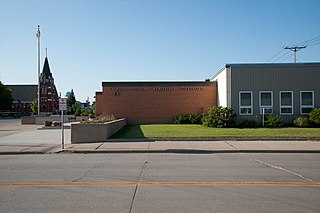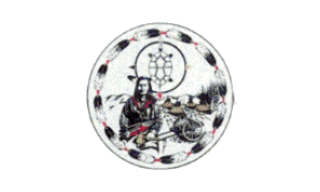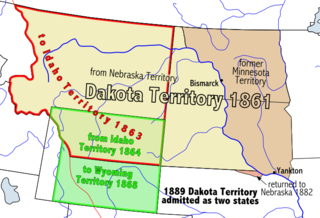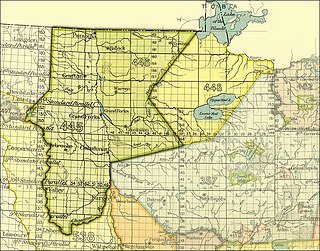
Walsh County is a county in the U.S. state of North Dakota. As of the 2020 census, the population was 10,563. Its county seat is Grafton.

Towner County is a county in the U.S. state of North Dakota. As of the 2020 census, the population is 2,162. Its county seat is Cando. It is south of the Canada–US border with Manitoba.

Cavalier County is a county in the U.S. state of North Dakota. It is south of the Canada–US border with Manitoba. As of the 2020 census, the population was 3,704. Its county seat is Langdon. The city of Cavalier is in nearby Pembina County.

Kittson County is a county in the northwestern corner of the U.S. state of Minnesota along the Canada–US border, south of the Canadian province of Manitoba. As of the 2020 census, the population was 4,207. Its county seat is Hallock.
Badger Township is a township in Polk County, Minnesota, United States. It is part of the Grand Forks-ND-MN Metropolitan Statistical Area. Under the United States Public Land Survey System it is a survey township identified as Township 149 North, Range 42 West, Fifth Principal Meridian. The population was 166 at the 2000 census.

Pembina is a city in Pembina County, North Dakota, United States. The population was 512 at the 2020 census. Pembina is located 2 miles (3.2 km) south of the Canada–US border. Interstate 29 passes on the western side of Pembina, leading north to the Canada–US border at Emerson, Manitoba and south to the cities of Grand Forks and Fargo. The Pembina–Emerson Border Crossing is the busiest between Surrey–Blaine, and Windsor–Detroit, and the fifth busiest along the Canada-United States border. It is one of three 24-hour ports of entry in North Dakota, the others being Portal and Dunseith. The Noyes–Emerson East Border Crossing, located 2 miles (3.2 km) to the east on the Minnesota side of the Red River, also processed cross-border traffic until its closure in 2006.

The Red Lake Indian Reservation covers 1,260.3 sq mi in parts of nine counties in Minnesota, United States. It is made up of numerous holdings but the largest section is an area about Red Lake, in north-central Minnesota, the largest lake in the state. This section lies primarily in the counties of Beltrami and Clearwater. Land in seven other counties is also part of the reservation. The reservation population was 5,506 in the 2020 census.

The Turtle Mountain Band of Chippewa Indians is a federally recognized Native American tribe of Ojibwe based on the Turtle Mountain Indian Reservation in Belcourt, North Dakota. The tribe has 30,000 enrolled members. A population of 5,815 reside on the main reservation and another 2,516 reside on off-reservation trust land.
Advance Township is a township in Pembina County, North Dakota, United States. At the time of the 2000 Census, its population was 143, with an estimated 122 people as of 2009.

The Pembina Region, also referred to as the Pembina District and Pembina Department, is the historic name of an unorganized territory of land that was ceded to the United States in 1818. The area included the portions of what became the States of Minnesota, North Dakota, and South Dakota lying within the Hudson Bay drainage basin. The area included settlements in the Pembina River area. The region was formerly part of British Rupert's Land, granted by British royal charter to the Hudson's Bay Company. After the Selkirk Concession and establishment of the agricultural Red River Colony in 1812, the area was governed as the District of Assiniboia. The Treaty of 1818 de jure transferred the region south of the 49th parallel to the United States from the British. Settlements south of the boundary continued to be de facto administered as part of Assiniboia until at least 1823.
Akra Township is a township in Pembina County, North Dakota, United States.
The Little Shell Band of Chippewa are a historic sub-band of the Pembina Band of Chippewa Indians led by Chief Little Shell in the nineteenth century. Based in North Dakota around the Pembina River, they are part of the Ojibwe, one of the Anishinaabe peoples, who occupied territory west of the Great Lakes by that time. Many had partial European ancestry from intermarriage by French-Canadian fur traders and trappers. Some began to identify as Métis, today recognized as one of the Indigenous Peoples of Canada. Located in the 17th century in the areas around the Great Lakes, they gradually moved west into North Dakota and Montana.
The Pembina Band of Chippewa Indians is a historical band of Chippewa (Ojibwe), originally living along the Red River of the North and its tributaries. Through the treaty process with the United States, the Pembina Band was settled on reservations in Minnesota and North Dakota. Some tribal members refusing settlement in North Dakota relocated northward and westward, some eventually settling in Montana. The traditional tribal leadership of Little Shell of The Pembina Band departed from The Turtle Mountain Band of Chippewa Indians and briefly camped in Dunsieth, ND where the Little Shell Campsite is memorialized, before residing at Spirit Lake, North Dakota, and Wolf Point, Montana.

Turtle Mountain, or the Turtle Mountains, is an area in central North America, in the north-central portion of the U.S. state of North Dakota and southwestern portion of the Canadian province of Manitoba, approximately 62 miles (100 km) south of the city of Brandon on Manitoba Highway 10 / U.S. Route 281. It is a plateau 2,000 ft above sea level, 300 ft to 400 ft above the surrounding countryside, extending 20 mi (32 km) from north to south and 40 mi (64 km) from east to west. Rising 1,031 feet (314 m), North Dakota's most prominent peak, Boundary Butte, is located at the western edge of the plateau.

Porter James McCumber was a United States senator from North Dakota. He was a supporter of the 1906 "Pure Food and Drug Act", and of the League of Nations.

The Pembina and Red Lake bands of Chippewa ceded to the United States the Red River Valley of the north in two treaties. Both were named for the treaty site, "Old Crossing" and the year, Treaty of Old Crossing (1863) and the Treaty of Old Crossing (1864). In Minnesota, the ceded territory included all land west of a line running generally southwest from the Lake of the Woods to Thief Lake, about 30 miles (48 km) west of Red Lake, and then angling southeast to the headwaters of the Wild Rice River near the divide separating the watersheds of the Red River of the North and the Mississippi River. In North Dakota, the ceded territory was all of the Red River Valley north of the Sheyenne River. In size, the area was roughly 127 miles (204 km) east-west and 188 miles (303 km) north-south, making it nearly 11,000,000 acres (45,000 km2) of prairie and forest.

Little Shell Tribe of Chippewa Indians of Montana is a federally recognized tribe of Ojibwe, Métis, and Cree people in Montana. The name of the tribe is often shortened to Little Shell. The current population of enrolled tribal members is approximately 6,600. They have a 35,000-sq. foot office complex in Great Falls.
Thingvalla Township is a township in Pembina County, North Dakota, United States. The 2000 census reported a population of 121, and an estimated population of 103 as of 2009. President Ólafur Grímsson of Iceland visited the area in 1999 to dedicate a monument to poet K. N. Julius at Thingvalla Church, and Prime Minister Geir Haarde visited in 2007 to dedicate a memorial to the church, which burned to the ground in 2003.

Georges-Antoine Belcourt, also George Antoine Bellecourt, was a French Canadian Roman Catholic diocesan priest and missionary. Born in Baie-du-Febvre, Quebec, Belcourt was ordained in 1827. He established missions in areas of Quebec and Manitoba. On the frontier, he became involved in a political dispute between the local First Nations population and the Hudson's Bay Company, the monopoly fur trading company.

Renwick Dam is a dam in Akra Township, Pembina County, North Dakota, USA, in the northeastern corner of the state.





















